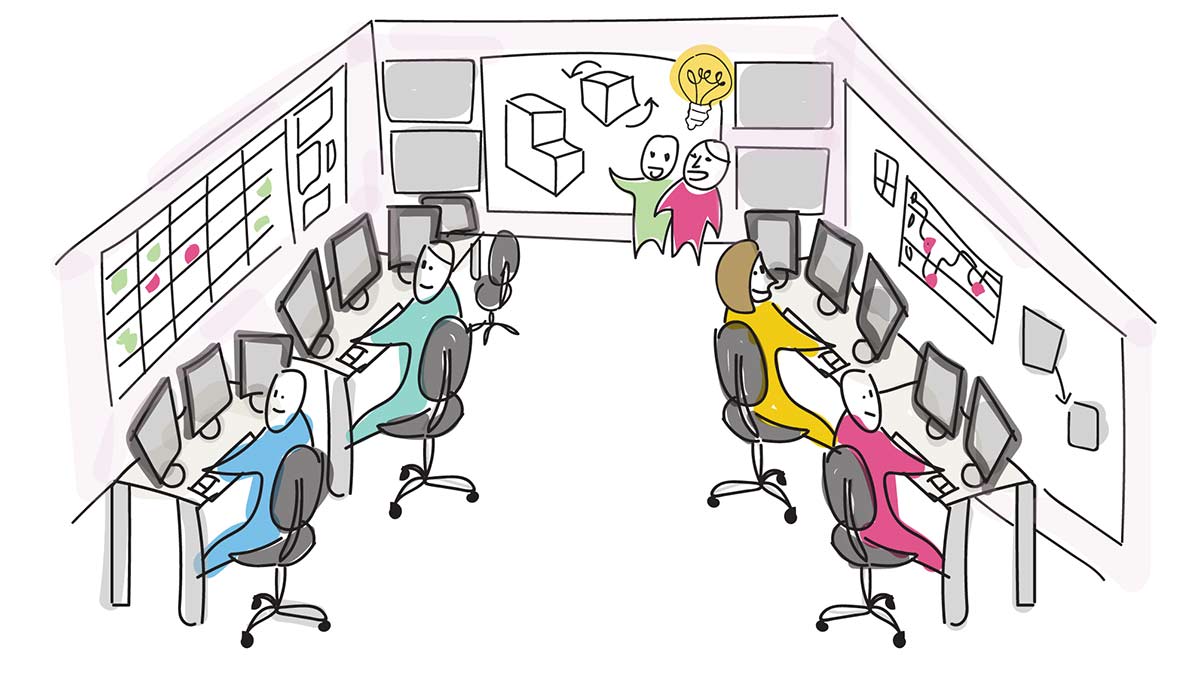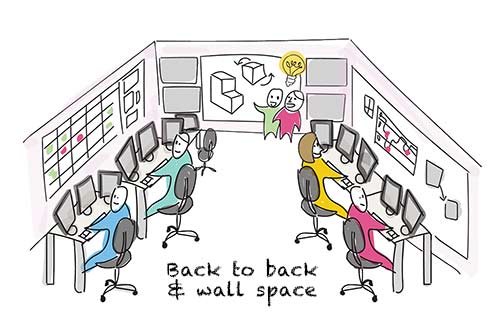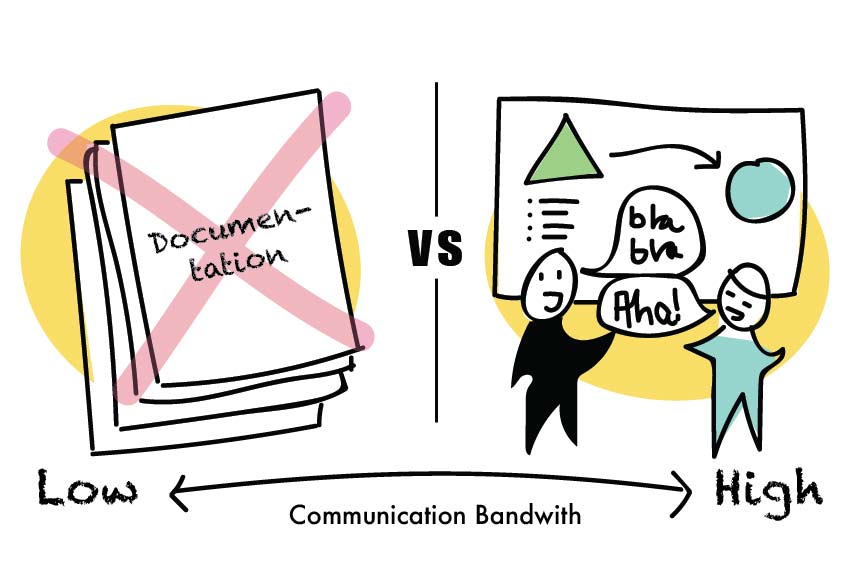 There is a an increasing trend in big companies and organizations to go Agile, and of course that is awesome in my opinion. What is really confusing though, is that many of the same companies and organizations also decide to change to activity based seating. This is really confusing in many ways, since it will bring contradictory behaviors than what you are looking for when working Agile, and in the short – and long run, make the company fail to go agile.
There is a an increasing trend in big companies and organizations to go Agile, and of course that is awesome in my opinion. What is really confusing though, is that many of the same companies and organizations also decide to change to activity based seating. This is really confusing in many ways, since it will bring contradictory behaviors than what you are looking for when working Agile, and in the short – and long run, make the company fail to go agile.
Recent posts in this series:
– Free Infographic “Get seated for Agile”
– The Free Report “The Agile Activity Based Seating Report 2018”
– Free PP slides of the report
– Video of me presenting the report (Swedish)
The only conclusion I can do, is that there is not enough knowledge around how Agile seatings need to be – nor what the consequences of not being Agile when trying will be (costly and frustrating). Or perhaps it’s that the people that do the work (and know about this) and the people making these decisions are too far away from each other and don’t communicate in a good way. Either way, it’s a huge waste – and so unnecessary.
I have several times been contacted by people working in organizations where they have had Agile teams sitting and working together with good results – and out of the blue, usually over a weekend or over a holiday, their office space was changed in to activity based seating with clean desk – and clean wall policy. The team shows up on a Monday finding all their stuff that was put up on the walls in a cardboard box and their 2-3 computer screens gone… These people tell tales about how their colleagues went home after that day, refused to come back in weeks. Their delivery pace went down with below 50% of normal and quality of work and innovation went down the drain totally. Everything the team had fought for to build up was erased over night.
Flexibility in Agile and Activity based offices must be a perfect fit – or does it?
Organizations that decide to go with activity based offices probably have the best of intentions. I’m sure of that, people usually do. But I’m also sure they need better advisory. It might look as if the flexibility in both agile and activity based office works really well together (and this is an argument I’ve heard sales people for these solution use). And it might look like you will save a lot of money, not having as many seatings as before, and it might look like people will get to know each other a lot better when they move around every day, and you might think they will love their new updated beautiful workplace with special designed chairs for people who like to sit alone not seeing or being seen by any one else. But it´s all wrong – so wrong – at least if you want collaboration, innovation and high speed in your organization and culture. Flexibility is not always what you need after all.
So let me try to explain the Top 4 contradictions between Agile and Activity based offices (flexible seating):
-
Stable teams that feel safe deliver at high speed
 Stable agile teams are the core in Agile, the number one thing you need to become Agile. What you are looking fore are teams that always sit and work together with the same focus over perhaps one or several years. When Agile teams get to know each other well they feel safe and they can then get to high speed and deliver much more than what you do in project organizations. A second factor to high speed is that since Agile teams work on things with the same focus they waste less time switching between tasks making them much faster than in project based organizations . A third factor connected to high speed delivery is belonging to a team, this safety is gone if you force people to instead focus on where their team will be during the day, or if they will be in time to take the seats they try to occupy as a team.
Stable agile teams are the core in Agile, the number one thing you need to become Agile. What you are looking fore are teams that always sit and work together with the same focus over perhaps one or several years. When Agile teams get to know each other well they feel safe and they can then get to high speed and deliver much more than what you do in project organizations. A second factor to high speed is that since Agile teams work on things with the same focus they waste less time switching between tasks making them much faster than in project based organizations . A third factor connected to high speed delivery is belonging to a team, this safety is gone if you force people to instead focus on where their team will be during the day, or if they will be in time to take the seats they try to occupy as a team.– Activity based offices bans people from sitting together as stable teams – therefor speed of delivery will drop dramatically.
-
Collaboration when ever you need to be able to innovate and solve tricky problems
 What´s also so great with Agile teams is that they sit together and therefor they have easy access to each other. The preferred layout is as in the visual in the top of this post, where team members have their backs to each other – so that when ever they need they can get together in front of someones screen or whiteboard and pair-work to solve tricky problems together. All this breaks terribly when they get forced to sit by themselves with no space to collaborate.
What´s also so great with Agile teams is that they sit together and therefor they have easy access to each other. The preferred layout is as in the visual in the top of this post, where team members have their backs to each other – so that when ever they need they can get together in front of someones screen or whiteboard and pair-work to solve tricky problems together. All this breaks terribly when they get forced to sit by themselves with no space to collaborate.– Activity based offices forces people to book meetings in meeting rooms to be able to collaborate. This makes pace slow down dramatically, as well as problem solving and innovation.
-
Visualization to collaborate and improving everything at all times
 Agile teams continuously improve everything and visualization is key to find problems. That´s why agile teams need to freely use wall space to visualize how the team is doing, what they are working on or who is on vacation when, or when the next demo or user testing will take place. When Agile teams get forced to put all this information in digital spaces the benefit of the information for the team usually in most parts gets lost.
Agile teams continuously improve everything and visualization is key to find problems. That´s why agile teams need to freely use wall space to visualize how the team is doing, what they are working on or who is on vacation when, or when the next demo or user testing will take place. When Agile teams get forced to put all this information in digital spaces the benefit of the information for the team usually in most parts gets lost.– Activity based offices with no dedicated (close to the team) wall space for teams, and perhaps even clean wall policy, dramatically hurts the collaboration and improvement process and creates dysfunctional teams, organizations and products.
-
Autonomous and at the same time aligned with high responsibility
You can think of Agile teams like a small micro startups that belong in a eco system with other startups and some times depend on each other to reach business goals. They take care of many things themselves that in other organizations might be done at management level or by HR. They might handle everything from hiring new people to the team, syncing vacation plans for team members to prioritizing what to work on or not.
 This as the same time as they are responsible for communicating with other teams to sync on what they are working on, or communicating to stakeholders what they are about to deliver when and making sure they create business value – at the same time as they are always delivering valuable work, minimizing waste and improving their ways of working. When problems arise in the team they are responsible for solving it within the team, removing the impediments, or to be transparent so that managers or others can help solve them. If the team then get pushed to work in a way they don´t consider to be good for them there will be problems when they can not solve it and no one help them to do so either.
This as the same time as they are responsible for communicating with other teams to sync on what they are working on, or communicating to stakeholders what they are about to deliver when and making sure they create business value – at the same time as they are always delivering valuable work, minimizing waste and improving their ways of working. When problems arise in the team they are responsible for solving it within the team, removing the impediments, or to be transparent so that managers or others can help solve them. If the team then get pushed to work in a way they don´t consider to be good for them there will be problems when they can not solve it and no one help them to do so either.– Activity based offices is, as far as I´ve seen, always something pushed from above. This is in contradiction to Agile values and Agile mindset, and therefore doomed to fail, especially if no one is there to support, listen and help the teams. Then the trust is gone and it might be very difficult to repair, hurting both culture and outcomes. Probably the opposite to what the people deciding to go with activity based offices wanted to achieve.
So what can you do instead?
Start with asking your agile teams what they need to be able to deliver value in the best way. Doing this you make sure you have the same goal, and you build trust. Listening is always a great start, making you a servant leader and your organization will move towards becoming future proof outlearning your competitors 🙂
Good luck with your Agile seating and building that Agile mindset!
I have been thinking about writing this post for years, all since I first saw the impact of these kind of decisions. But knowing how hard it will be not to go in to rant mode has kept me from not getting there… this was my last and final try.
I hope it can bring value to those of you who perhaps are thinking about changing into this kind of seating (I know many are) – and to those of you who have perhaps already gone this, that what you can do to fix it. You are welcome to contact me if you have an interest to discuss more about how Agile team seatings could be to serve the teams in the best way.
Here you can take the Survey to let us know what you think about activity based offices
It inly takes a couple of minutes and contains of 10 questions.


